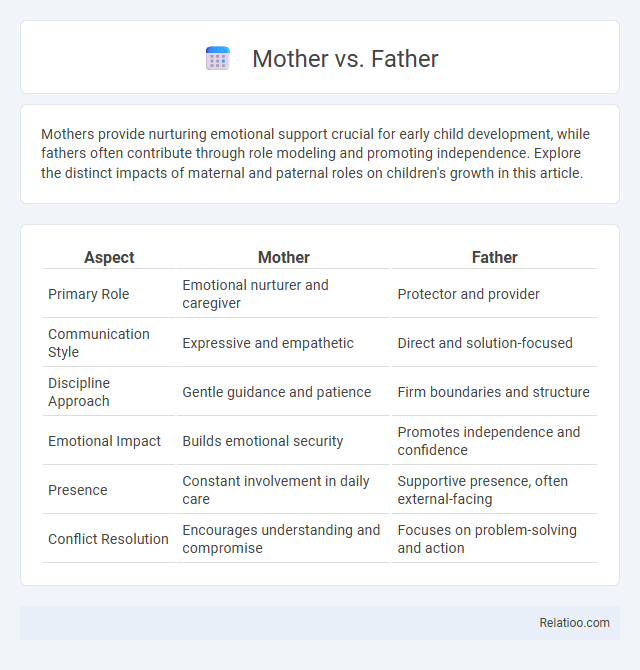Mothers provide nurturing emotional support crucial for early child development, while fathers often contribute through role modeling and promoting independence. Explore the distinct impacts of maternal and paternal roles on children's growth in this article.
Table of Comparison
| Aspect | Mother | Father |
|---|---|---|
| Primary Role | Emotional nurturer and caregiver | Protector and provider |
| Communication Style | Expressive and empathetic | Direct and solution-focused |
| Discipline Approach | Gentle guidance and patience | Firm boundaries and structure |
| Emotional Impact | Builds emotional security | Promotes independence and confidence |
| Presence | Constant involvement in daily care | Supportive presence, often external-facing |
| Conflict Resolution | Encourages understanding and compromise | Focuses on problem-solving and action |
Defining the Roles: Mother vs Father
Mother and father roles traditionally encompass distinct but complementary responsibilities, where the mother often focuses on nurturing and emotional support, while the father typically assumes the role of protector and provider. Your family's hierarchy is influenced by cultural, social, and individual dynamics, shaping how authority and decision-making power are distributed between parents. Understanding these role definitions helps clarify expectations and strengthens family cohesion.
Historical Perspectives on Parenting
Historical perspectives on parenting reveal distinct roles assigned to mothers and fathers within hierarchical family structures. Mothers traditionally assumed primary caregiving responsibilities, nurturing emotional bonds and managing daily child-rearing tasks, while fathers often fulfilled authoritative roles, providing financial support and enforcing discipline. Cultural variations influenced these dynamics, reflecting societal values and power distributions embedded in patriarchal or matriarchal systems throughout history.
Emotional Bonding: Maternal and Paternal Differences
Maternal emotional bonding typically involves nurturing behaviors that create a secure attachment through consistent caregiving and empathetic responses, fostering a child's sense of safety and trust. Paternal bonding often emphasizes play, exploration, and boundary-setting, which supports social development and resilience in children. Your child's emotional growth benefits from the complementary strengths of both maternal and paternal roles within the family hierarchy.
Nurturing Styles: How Mothers and Fathers Care
Mothers tend to exhibit nurturing styles that emphasize emotional warmth, consistent caregiving, and attentive responsiveness, which foster secure attachments in children. Fathers often provide nurturing through playful engagement, encouragement of risk-taking, and promoting independence, complementing maternal care by supporting self-confidence and social skills. Your understanding of these differing nurturing styles is crucial for appreciating how maternal and paternal roles uniquely contribute to a balanced family hierarchy and child development.
Discipline Approaches: Contrasts and Complementarities
Mothers often employ nurturing discipline strategies emphasizing emotional connection and consistent communication, fostering a secure environment for behavior correction. Fathers typically utilize authoritative approaches focusing on rules, boundaries, and consequences to instill self-discipline and responsibility. Together, parental discipline styles create a complementary hierarchy that balances warmth and structure, promoting holistic child development and effective behavioral regulation.
Financial Contributions and Responsibilities
Financial contributions within family dynamics often reflect traditional roles, with fathers typically being primary breadwinners and mothers managing household expenses and caregiving costs. Your understanding of this hierarchy can clarify budget management and accountability, ensuring that both parents share responsibilities fairly. Emphasizing transparent financial planning promotes collaboration and supports the well-being of all family members.
Societal Expectations and Gender Stereotypes
Societal expectations often place mothers as primary caregivers, reinforcing traditional gender stereotypes that emphasize nurturing roles for women and authority roles for fathers within family hierarchies. Fathers are frequently viewed as disciplinarians and financial providers, which shapes family dynamics and impacts how authority and responsibility are distributed. Understanding how these rigid roles influence your family interactions can help challenge outdated norms and promote more equitable gender roles.
Impact on Child Development
The impact of mother versus father roles on child development varies significantly, with mothers typically providing nurturing and emotional security, while fathers often contribute to cognitive growth and social skills through play and discipline. Hierarchical family structures influence children's sense of authority and autonomy, where balanced parental involvement fosters emotional resilience and adaptive behavior. Studies reveal that children exposed to collaborative parenting models exhibit enhanced problem-solving abilities and emotional regulation, underscoring the importance of both parental roles within family hierarchies.
Shared Parenting: Blending Maternal and Paternal Strengths
Shared parenting effectively blends maternal empathy and paternal discipline, fostering balanced child development. Integrating the nurturing qualities of mothers with the structured guidance from fathers promotes emotional security and social competence. This collaborative hierarchy enhances parenting efficacy by leveraging complementary strengths for holistic family well-being.
Evolving Roles in Modern Families
Evolving roles in modern families reflect a shift from traditional hierarchies to more egalitarian partnerships, with both mothers and fathers increasingly sharing responsibilities across childcare, household duties, and financial support. Mothers historically emphasized nurturing roles, but today their involvement spans career advancement and active decision-making alongside fathers who engage more deeply in emotional caregiving. This dynamic challenges conventional family hierarchies, promoting cooperation and flexibility to adapt to diverse family structures and societal changes.

Infographic: Mother vs Father
 relatioo.com
relatioo.com